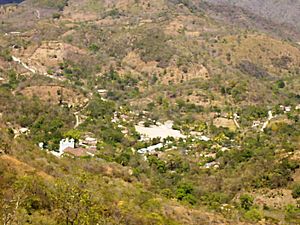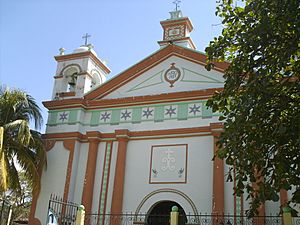San Francisco, Lempira facts for kids
San Francisco is a town, also called a municipality, located in the Lempira department in Honduras. It's one of the towns farthest away in the Lempira region.
Contents
A Look at History
The land where San Francisco now stands was given by the King of Spain on October 30, 1692. This land had two special names: "Santa Maria Magdalena" and "San Lucas." In 1791, records show it was part of an area called "Curato de Cerquin."
The town of San Francisco was officially started in 1837. This happened because of a person named Captain Jeronimo Acosta. A very old church was built in 1856. This church is a historical treasure left by the Spanish people who settled there long ago. If you look closely at the church in the picture, you might see the date 1737. This is interesting because it's different from the 1856 date. In 1896, when Honduras was divided into different areas, San Francisco was part of the Erandique district.
Where San Francisco Is
The main part of San Francisco is at the bottom of a hill called "Gelpoa." To reach the town, you travel up and down many mountains and hills. As you go down, the land gets closer to sea level. Because of this, the plants you see are usually found in dry, warm forests. The weather in San Francisco is warm for most of the year. In some areas where no one lives, you can find forests of pine trees.
What Borders San Francisco
San Francisco shares its borders with other places:
- North: The towns of Erandique.
- South: The Intibuca department.
- East: The town of Intibuca.
- West: The towns of Erandique and Piraera.
- Area: The total size of San Francisco is 133 square kilometers.
What San Francisco Has
The main crops grown in San Francisco are corn and beans. There are not many places suitable for growing coffee plants. People get their drinking water from wells dug in the ground and from small streams nearby. Local farms raise cattle, and the milk products are used by the people living in the town.
Just like other parts of the Lempira department, San Francisco has electricity. People can also use cell phones, and there is internet access at the mayor's office. There are many grocery stores where people can buy food and other items. Some homes also sell gasoline and diesel fuel for vehicles.
People of San Francisco
You will often see people in San Francisco who are descendants of the original Indigenous people. There are also some people who have mixed Spanish and Indigenous heritage.
- Population Count: In 2001, about 8,086 people lived in San Francisco. This number was used to estimate that the population grew to about 9,143 people.
- Villages: San Francisco includes 7 villages.
- Smaller Settlements: There are also 86 smaller communities or settlements.
Who Lives There
During the 2013 Honduras census, San Francisco municipality had 9,017 people. Most of them, about 91.76%, were Indigenous. About 7.53% were Mestizo (people of mixed European and Indigenous heritage). A smaller number, 0.69%, were Black or Afro-Honduran, and 0.02% were White.
Visiting San Francisco
Getting to San Francisco can be a bit of an adventure, requiring patience. If you are starting from Gracias, Lempira, you would travel towards San Juan del Caite in Intibuca. From there, you can take a road that leads to "San Miguelito, Intibuca" or Erandique. If you are in "La Esperanza, Intibuca," you would go to "San Miguelito" and then to "Dolores, Intibuca."
There is another road that connects Erandique and Dolores, Intibuca, in a community called "San Antonio." This road can be in poor condition for half of the year, so it's good to be careful.
The most interesting sight for visitors is probably the old church. The people in San Francisco are very friendly and welcoming to visitors.
- Local Celebrations: San Francisco has two main local holidays. One is "Virgen del Carmen" day on July 16. The other is "San Francisco de Asis" day, celebrated on October 4.
See also
 In Spanish: San Francisco (Lempira) para niños
In Spanish: San Francisco (Lempira) para niños





